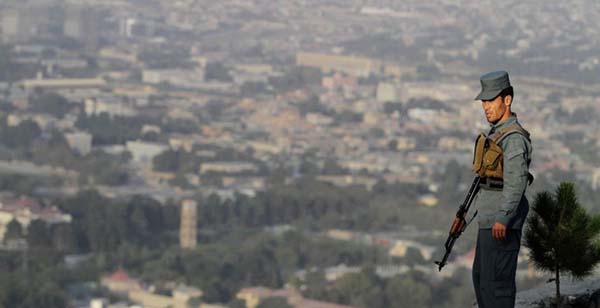Do we live under a democratic system? The irony is that democracy means violence and bloodshed inflicted upon a nation. Afghans struggle to survive suicide bombings, abduction and terrorist acts. The security situation is a matter of great worry for the people. The mouth-watering promises in presidential election were no more than a flash in the pan and Afghans’ expectations of democracy seem to never come true. Reports show that a myriad of people take their dream about peace and stability to the grave with them. Their ballots were changed into bullet to shed their blood before the eyes of their families – The completely opposite of what was intended of flocking to ballot boxes.
Reports say that at least 30 Afghan soldiers have been killed; eight of them decapitated, and several others were abducted after militants stormed army checkpoints in Jurm district of northeastern Badakhshan province last Friday when more than 200 militants launched an assault. However, a lawmaker from central Parwan province, Almas Zahid, said 62 troops had either been killed or missing. Zalmai Mujaddadi, representative of Badakhshan province to Lower House, said, “Militants have beheaded eight soldiers in ISIS’s style and have sent the bodies back to the government.” He added that, the check posts had been completely destroyed by insurgents while four armor vehicles, six police vans and several light and heavy weapons were taken. The Taliban claimed responsibility for the attack saying they had killed 49 soldiers and wounded 42 others, which was not confirmed by any independent sources.
Afghan Wolesi Jirga members said government officials had committed negligence in this regard urging President Ashraf Ghani and CEO Abdullah Abdullah to resign.
Fauzia Kofi, a female lawmaker from Faryab, said the Taliban had infiltrated in each home in Faryab under the leadership of three Pakistani generals, 12 Chechens and some Uzbek fighters. She warned if the situation in Faryab was not curbed, it could not be controlled from spreading to Mazar-i-Sharif, the capital of northern Balkh province. She urged the president and the CEO should resign because they could not heal the nation’s wounds.
The tragic murder of Afghan National Army has not only raised the parliamentarians’ concerns but came as a complete shock to Afghans’ bleeding nation. To their unmitigated chagrin, the security situation has been deteriorated in recent months. As a result, 33 people were killed and 125 other injured in a suicide blast in Jalalabad capital of Nangerhar province the other day. Also 31 Afghan travelers were abducted about two months ago on Herat-Kabul Highway and yet no serious action is taken for their release despite their families’ urges and public demonstrations.
The civilian casualties are more appalling for the nation. As a result, Latest figures from the United Nations Assistance Mission in Afghanistan (UNAMA) shows a continuing trend of record high civilian casualties, with deaths and injuries from ground engagements in Afghanistan remaining the leading cause.
A statement released by the UNAMA said that today, with the release of UNAMA’s findings from the first quarter of 2015, UNAMA called on all parties to the conflict to recognize and act to prevent harm to civilians.
“With the seasonal resumption of higher levels of conflict-related violence, the United Nations urges all parties to the conflict to take all necessary measures to protect civilians,” said Nicholas Haysom, the Secretary-General’s Special Representative for Afghanistan and head of UNAMA.
Haysom said: “The parties in particular should refrain from using mortars and rockets in any areas populated by civilians.”
In the first three months of 2015, civilian casualties from ground engagements rose by eight per cent compared to the same period in 2014. Ground fighting between pro-government forces and anti-government elements caused 521 civilian casualties, with 136 civilians killed and 385 injured.
Haysom said UNAMA was particularly concerned about the impact on civilians of further conflict-related operations by the Afghan National Security Forces and anti-government elements in the coming months.
Total civilian deaths and injuries in the first quarter of 2015 followed the record high levels of 2014. Between 1 January and 31 March, UNAMA documented 1,810 civilian casualties (655 deaths and 1,155 injured), a two per cent decrease from the same period in 2014.
The latest figures further demonstrated a continued rise in women casualties with an increase of 15 per cent on the same period last year. Conflict-related violence killed 55 women and injured 117. Child casualties surpassed the unprecedented levels recorded last year with 430 child civilian casualties (123 deaths and 307 injured). In line with increased ground fighting in civilian populated areas, ground engagements remained the leading cause of women and children civilian casualties, the statement added.
Targeted killings were the third leading cause of civilian deaths and injuries. In the first three months of 2015, civilian casualties from targeted killings increased by 34 per cent, with UNAMA documenting 309 civilian casualties (217 killed and 92 injured) in 192 separate incidents.
The Taliban claimed responsibility for 48 incidents of targeted killings, including deliberate killings of tribal elders, judges, prosecutors and civilian government workers. Under international humanitarian law, a civilian is any person who is not taking a direct part in hostilities.
In our democratic system, the casualties and bloodshed can no more arouse the officials’ concerns. A lot has been said and written about the insecurity and tragic incidents, yet no effective strategy is adopted to curb the situation.

